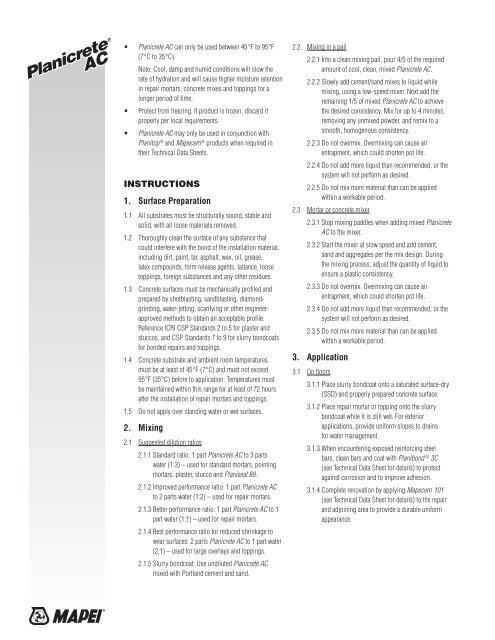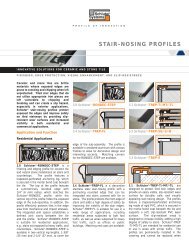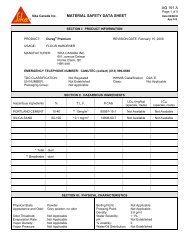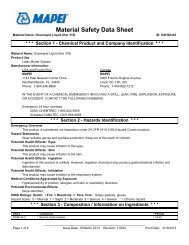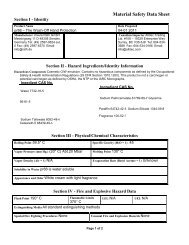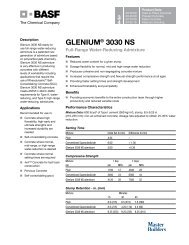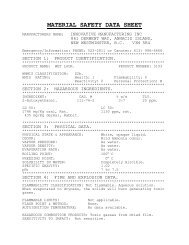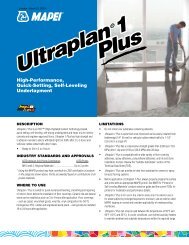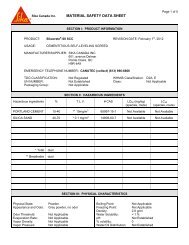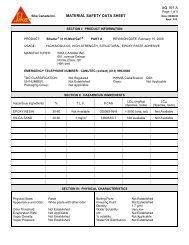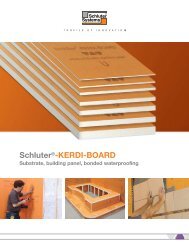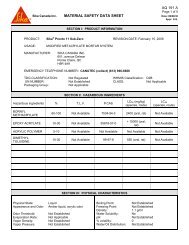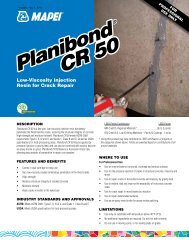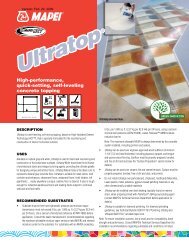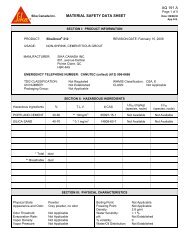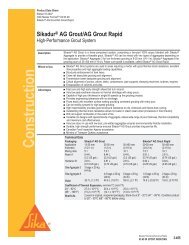Planicrete AC Planicrete AC - Northland Construction Supplies
Planicrete AC Planicrete AC - Northland Construction Supplies
Planicrete AC Planicrete AC - Northland Construction Supplies
You also want an ePaper? Increase the reach of your titles
YUMPU automatically turns print PDFs into web optimized ePapers that Google loves.
<strong>Planicrete</strong> ®<br />
<strong>AC</strong><br />
• <strong>Planicrete</strong> <strong>AC</strong> can only be used between 45°F to 95°F<br />
(7°C to 35°C).<br />
Note: Cool, damp and humid conditions will slow the<br />
rate of hydration and will cause higher moisture retention<br />
in repair mortars, concrete mixes and toppings for a<br />
longer period of time.<br />
• Protect from freezing. If product is frozen, discard it<br />
properly per local requirements.<br />
• <strong>Planicrete</strong> <strong>AC</strong> may only be used in conjunction with<br />
Planitop ® and Mapecem ® products when required in<br />
their Technical Data Sheets.<br />
INSTRUCTIONS<br />
1. Surface Preparation<br />
1.1 All substrates must be structurally sound, stable and<br />
solid, with all loose materials removed.<br />
1.2 Thoroughly clean the surface of any substance that<br />
could interfere with the bond of the installation material,<br />
including dirt, paint, tar, asphalt, wax, oil, grease,<br />
latex compounds, form release agents, laitance, loose<br />
toppings, foreign substances and any other residues.<br />
1.3 Concrete surfaces must be mechanically profiled and<br />
prepared by shotblasting, sandblasting, diamondgrinding,<br />
water-jetting, scarifying or other engineerapproved<br />
methods to obtain an acceptable profile.<br />
Reference ICRI CSP Standards 2 to 5 for plaster and<br />
stuccos, and CSP Standards 7 to 9 for slurry bondcoats<br />
for bonded repairs and toppings.<br />
1.4 Concrete substrate and ambient room temperatures<br />
must be at least of 45°F (7°C) and must not exceed<br />
95°F (35°C) before to application. Temperatures must<br />
be maintained within this range for at least of 72 hours<br />
after the installation of repair mortars and toppings.<br />
1.5 Do not apply over standing water or wet surfaces.<br />
2. Mixing<br />
2.1 Suggested dilution ratios<br />
2.1.1 Standard ratio: 1 part <strong>Planicrete</strong> <strong>AC</strong> to 3 parts<br />
water (1:3) – used for standard mortars, pointing<br />
mortars, plaster, stucco and Planiseal 88.<br />
2.1.2 Improved performance ratio: 1 part <strong>Planicrete</strong> <strong>AC</strong><br />
to 2 parts water (1:2) – used for repair mortars.<br />
2.1.3 Better performance ratio: 1 part <strong>Planicrete</strong> <strong>AC</strong> to 1<br />
part water (1:1) – used for repair mortars.<br />
2.1.4 Best performance ratio for reduced shrinkage to<br />
wear surfaces: 2 parts <strong>Planicrete</strong> <strong>AC</strong> to 1 part water<br />
(2:1) – used for large overlays and toppings.<br />
2.1.5 Slurry bondcoat: Use undiluted <strong>Planicrete</strong> <strong>AC</strong><br />
mixed with Portland cement and sand.<br />
2.2 Mixing in a pail<br />
2.2.1 Into a clean mixing pail, pour 4/5 of the required<br />
amount of cool, clean, mixed <strong>Planicrete</strong> <strong>AC</strong>.<br />
2.2.2 Slowly add cement/sand mixes to liquid while<br />
mixing, using a low-speed mixer. Next add the<br />
remaining 1/5 of mixed <strong>Planicrete</strong> <strong>AC</strong> to achieve<br />
the desired consistency. Mix for up to 4 minutes,<br />
removing any unmixed powder, and remix to a<br />
smooth, homogenous consistency.<br />
2.2.3 Do not overmix. Overmixing can cause air<br />
entrapment, which could shorten pot life.<br />
2.2.4 Do not add more liquid than recommended, or the<br />
system will not perform as desired.<br />
2.2.5 Do not mix more material than can be applied<br />
within a workable period.<br />
2.3 Mortar or concrete mixer<br />
2.3.1 Stop mixing paddles when adding mixed <strong>Planicrete</strong><br />
<strong>AC</strong> to the mixer.<br />
2.3.2 Start the mixer at slow speed and add cement,<br />
sand and aggregates per the mix design. During<br />
the mixing process, adjust the quantity of liquid to<br />
ensure a plastic consistency.<br />
2.3.3 Do not overmix. Overmixing can cause air<br />
entrapment, which could shorten pot life.<br />
2.3.4 Do not add more liquid than recommended, or the<br />
system will not perform as desired.<br />
2.3.5 Do not mix more material than can be applied<br />
within a workable period.<br />
3. Application<br />
3.1 On floors<br />
3.1.1 Place slurry bondcoat onto a saturated surface-dry<br />
(SSD) and properly prepared concrete surface.<br />
3.1.2 Place repair mortar or topping onto the slurry<br />
bondcoat while it is still wet. For exterior<br />
applications, provide uniform slopes to drains<br />
for water management.<br />
3.1.3 When encountering exposed reinforcing steel<br />
bars, clean bars and coat with Planibond ® 3C<br />
(see Technical Data Sheet for details) to protect<br />
against corrosion and to improve adhesion.<br />
3.1.4 Complete renovation by applying Mapecem 101<br />
(see Technical Data Sheet for details) to the repair<br />
and adjoining area to provide a durable uniform<br />
appearance.


